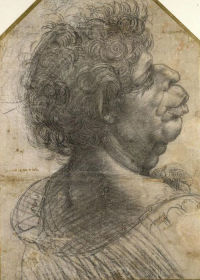
- Enlarge
- © Christ Church Picture Gallery
Bust of grotesque man in profile facing to the right c1503-05
This cartoon, which is almost life-size, is the largest of a series
of drawings of grotesque heads produced by Leonardo between 1490 and
1505, and represents the culmination of his interest in exaggerated
physiognomy.
Giorgio Vasari, the 16th century biographer of Leonardo, called such heads teste bizzare or “bizzare heads”. It is unlikely that these studies were drawn from life. In the Codex Urbinas,
Leonardo notes that “those who have facial features of great relief and
depth are bestial and wrathful men, men of little reason”.
The twisted pose of the man, who is seen from the back with his head
turned sharply to the right, allows Leonardo to achieve a sense of
sculptural form in the body whilst emphasising his grotesque features
by showing them in profile. The bold, broad handling of the charcoal
(or chalk) and the vigorous reinforcement of lines may give some idea
of the technique of the lost cartoon for the iBattle of Anghiari fresco, executed around the same time.
The outlines of this drawing have been pricked and pounced with
charcoal dust in order to transfer the design to another surface.
The inscription LIONARDO DA VINCI on the left of the sheet is written in an 18th century hand.
- Medium Charcoal or black chalk, pricked for transfer
- Size 382 x 275 cm
- Location Christ Church Picture Gallery

